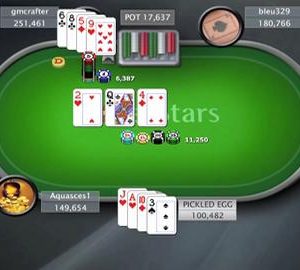Omaha Hi-Lo Sit and Go Reinforces Key Strategy Concepts

The other night, I was playing a No-Limit Omaha Hi-Lo Sit-N-Go and as the game went on, it became a classic example of certain key strategy concepts in the game. Below are a few of those concepts and how they came into play in my game.
If You Draw, Draw to the Nuts
It amazes me how many players fail to draw to the nuts in this game. Two key hands that won me big pots were demonstrative of this concept. First, I was dealt As-3d-10s-Kh in the big blind. There were two other limpers in the pot and the small blind called. The flop fell 2s-8s-Jd. I flopped both the nut low draw and the nut flush draw.
I bet out the size of the pot on the flop to see if I could thin the field out for any other lows. I received two callers and the 4s hit the turn. I hit both draws in one card. I again bet out the size of the pot and again was called in two spots. The river fell the 9d and I moved all-in. I was called in one spot and my opponent showed A-2-J-6 for two pair and weaker low.
The second big pot I speculated with a hand of Qs-Qd-10s-Jd. Again, the pot had three players see the flop that fell Js-8d-9h. This time I flopped the nuts. Some might slow play here, but I bet out and was called in two spots again. The turn brought a low draw to the board and I again bet the size of the pot. One player made the call and the river fell a king to improve my straight. Sadly, this also improves my opponent to two pair, and he went all-in and out when I showed the nuts.
Beware When the Board is Paired
A pot where I wisely excused myself from after the flop started out paired when it fell 6-7-6. I started with a double suited A-3-J-Q this hand. I was lucky enough to be on the button and watched as three players ahead of me acted. It went bet 1/4 the size of the pot, raise around the size of the pot, and then call before it got to me. I needed a deuce to win 1/2 at best, so out I went.
The turn fell the three, and the first player moved all-in. Both opponents were shorter than him and made the call. The two shorter stacks had A-2 with one having A-2-3-6. Normally that would be good enough to win, except for the fact that the original bettor had two sevens in his hand for the nut full house. The case six failed to hit the river and I saved myself a lot of money remembering this concept.
Don’t Fall in Love With Naked Aces
For those that aren’t familiar with the term naked aces, that means an Omaha hand with a pair of aces that has not other legitimate coordination. This means no decent low draw, no straight or flush draws, etc. I started the hand with Ah-2h-4c-Kc and my opponent min-raised pre-flop. I was in position and made the call to see the flop. The flop then fell Kh-5h-2d. I had a pair with a double nut draw. My opponent then moved all-in, which was about the size of the pot. I made the call to see him flip over Ac-Ad-8h-10s. He had aces only. I wound up hitting both my flush and the low to take the hand and knock him out.
Now I wish I could tell you that I took the standard concepts learned and won the Sit-N-Go with them, but I actually finished second. In the final hand, I decided to play the 2nd nut low overly aggressively and ran into a nut low and a better high hand. As you can see, we all can make mistakes when playing Omaha Hi-Lo. The key is to keep from frequently making those mistakes. Doing so will help you win more pots, grow your bankroll, or win more events. Good luck to you at the tables.
